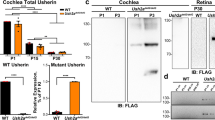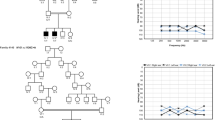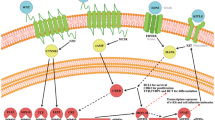Abstract
Splotch is considered a model of Waardenburg syndrome type I (WSI) because the abnormalities are caused by mutations in homologous genes, Pax–3 in mice and PAX3 (HuP2) in humans. We examined inner ear structure and function in Splotch mutants (Sp/+) and found no sign of auditory defects, in contrast to the deafness in many WSI individuals. The difference in expression of the genes in the two species may be due to different parts of the gene being mutated, or may result from variations in modifying influences as yet undefined.
This is a preview of subscription content, access via your institution
Access options
Subscribe to this journal
Receive 12 print issues and online access
$209.00 per year
only $17.42 per issue
Buy this article
- Purchase on Springer Link
- Instant access to full article PDF
Prices may be subject to local taxes which are calculated during checkout
Similar content being viewed by others
References
Newton, V. Hearing loss and Waardenburg's syndrome: Implications for genetic counselling. J. Laryng. Otol. 104, 97–103 (1990).
Hageman, M.J. & Delleman, J W Heterogeneity in Waardenburg syndrome. Am. J. hum. Genet. 29, 468–485 (1977).
Farrer, L.A., et al. Waardenburg syndrome (WS) type I is caused by defects at multiple loci, one of which is near ALPP on chromosome 2: First report of the WS Consortium. Am. J. hum. Genet. 50, 902–913 (1992).
Asher, J.H. & Friedman, T.B. Mouse and hamster mutants as models for Waardenburg syndromes in humans. J. med. Genet. 27, 618–626. (1990).
Foy, C., Newton, V., Wellesley, D., Harris, R. & Read, A.P. Assignment of the locus for Waardenburg syndrome type 1 to human chromosome 2q37 and possible homology to the Splotch mouse. Am. J. hum. Genet. 46, 1017–1023 (1990).
Auerbach, R. Analysis of the developmental effects of a lethal mutation in the house mouse. J. exp. Zool. 127, 305–329 (1954).
Deol, M.S. Influence of the neural tube on the differentiation of the inner ear in the mammalian embryo. Nature 209, 219–220 (1966).
Epstein, D.J., Vekemans, M. & Gros, P. Splotch (Sp2H), a mutation affecting development of the mouse neural tube, shows a deletion within the paired homeodomain of Pax-3. Cell 67, 767–774 (1991).
Goulding, M.D., Chalepakis, G., Deutsch, U., Erselius, J.R. & Gruss, P. Pax-3, a novel murine DNA binding protein expressed during early neurogenesis. EMBO J. 10, 1135–1147 (1991).
Tassabehji, M., et al. Waardenburg's syndrome patients have mutations in the human homologue of the Pax-3 paired box gene. Nature 355, 635–636 (1992).
Baldwin, C.T., Hoth, C.F., Amos, J.A., da-Silva, E.O. & Milunsky, A. An exonic mutation in the HuP2 paired domain gene causes Waardenburg's syndrome. Nature 355, 637–638 (1992).
Burri, M., Tromvoukis, Y., Bopp, D., Frigerio, G. & Noll, M. Conservation of the paired domain in metazoans and its structure in three isolated human genes. EMBO J. 8, 1183–1190 (1989).
Johnstone, J.R., Alder, V.A., Johnstone, B.M., Robertson, D. & Yates, G.K. Cochlear action potential threshold and single unit thresholds. J. Acoust. Soc. Am. 65, 254–257 (1979).
Patuzzi, R.B., Yates, G.K. & Johnstone, B.M. The origin of the low-frequency microphonic in the first cochlear turn of guinea-pig. Hearing Res. 39, 177–188 (1989).
Rarey, K.E. & Davis, L.E. Inner ear anomalies in Waardenburg's syndrome associated with Hirschsprung's disease. Int. J. Pediat. Otorhinolaryngol. 8, 181–189 (1984).
Fisch, L. (1959) Deafness as part of an hereditary syndrome. J. Lar. Otol. 73, 355–383.
Nemansky, J. & Hageman, M.J. Tomographic findings of the inner ears of 24 patients with Waardenburg's syndrome. Am. J. Roentgenol. Radium Ther. Nucl. Med. 124, 250–255 (1975).
Marcus, R.E. Recognition and diagnosis of hereditary deafness with tomographic correlates. Tr. Am. Acad. Ophth. 73, 409–419 (1969).
Marcus, R.E. & Valvassori, G. Cochleo-vestibular apparatus: radiologic studies in hereditary and familial hearing loss. Int. Audiol. 9, 95–102 (1970).
Jensen, J. Tomography of inner ear in case of Waardenburg's syndrome. Am. J. Roentgenol., Rad. Ther. Nuclear Med. 101, 828–833 (1967).
Irie, K., Ogata, H. & Mitsudome, A. CT findings of the temporal bones in Waardenburg's syndrome. No To Hattatsu 22, 241–246 (1990).
Hageman, M.J. & Oosterveld, W.J. Vestibular findings in 25 patients with Waardenburg's syndrome. Arch. Otolaryngol. 103, 648–652 (1977).
Galich, R. Temporal bone involvement in Waardenburg's syndrome. Ear, Nose Throat J. 64, 441–445 (1985).
Hildesheimer, M., Maayan, Z., Muchnik, C., Rubinstein, M. & Goodman, R.M. Auditory and vestibular findings in Waardenburg's type II syndrome. J. Lar. Otol. 103, 1130–1133 (1989).
Deol, M.S. Genetic malformations of the inner ear in the mouse and in man. Birth Defects: Original article series 16, 243–261 (1980).
Wright, J.L.W., Phelps, P.O. & Friedmann, I. Temporal bone studies in anencephaly. J. Lar. Otol. 90, 919–927 (1976).
Steel, K.P. & Bock, G.R. Hereditary inner ear abnormalities in animals. Relationship with human abnormalities. Arch. Otolaryngol. 109, 22–29 (1983).
Kapron-Bras, C.M. & Trasler, D.G. Reduction in the frequency of neural tube defects in Splotch mice by retinoic acid. Teratology 32, 87–92 (1985).
Steel, K.P., Barkway, C. & Bock, G.R. Strial dysfunction in mice with cochleo-saccular abnormalities. Hearing Res. 27, 11–26 (1987).
Steel, K.P. & Barkway, C. Another role for melanocytes: their importance for normal stria vascularis development in the mammalian inner ear. Development 107, 453–463 (1989).
Hulten, M.A., Honeyman, M.M., Mayne, A.J. & Tarlow, M.J. Homozygosity in piebald trait. J. Med. Genet. 24, 568–571 (1987).
Morell, R. et al. A frameshift mutation in the HuP2 paired domain of the probable human homolog of murine Pax-3 is responsible for Waardenburg Syndrome Type 1 in an Indonesian family. Human molec. Genet. (in the press).
Kuehn, M.R., Bradley, A., Robertson, E.J. & Evans, M.J.A. potential animal model for Lesch-Nyhan syndrome through introduction of HPRT mutations into mice. Nature 326, 295–298 (1987).
Hoffman, E.P., Brown, R.H. & Kunkel, L.M. Dystrophin: The protein product of the Duchenne muscular dystrophy locus. Cell 51, 919–928 (1987).
Konyukhov, B.V. & Mironova, O.V. Interaction of the mutant genes splotch and fidget in mice. Soviet Genet. 15, 407–411 (1979).
Moase, C.E. & Trasler, D.G. Splotch locus mouse mutants: models for neural tube defects and Waardenburg syndrome type I in humans. J. med. Genet. 29, 145–151 (1992).
Henry, K.R. & Lepkowski, C.M. Evoked potential correlates of genetic progressive hearing loss. Acta Otolaryng. 86, 366–374 (1978).
Walther, C. & Gruss, P. Pax-6, a murine paired box gene, is expressed in the developing CNS. Development 113, 1435–1449 (1991).
Deutsch, U. & Gruss, P. Murine paired domain proteins as regulatory factors of embryonic development. Sem. devel. Biol. 2, 413–424 (1991).
Chalepakis, G. et al. The molecular basis of the undulated/Pax-1 mutation. Cell 66, 873–884 (1991).
Author information
Authors and Affiliations
Rights and permissions
About this article
Cite this article
Steel, K., Smith, R. Normal hearing in Splotch (Sp/+), the mouse homologue of Waardenburg syndrome type 1. Nat Genet 2, 75–79 (1992). https://doi.org/10.1038/ng0992-75
Received:
Accepted:
Issue Date:
DOI: https://doi.org/10.1038/ng0992-75



